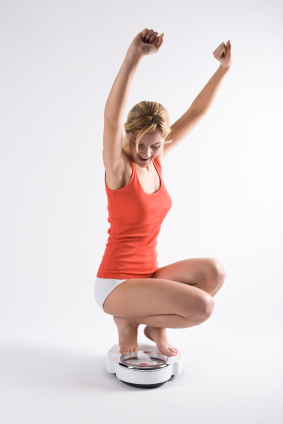
Fat Burning Exercise Program | Page | 1 | 2 |
Building good-looking muscles is only part of quest from your fat burning exercise program.
If you want to improve your muscle definition and reduce your body fat,
you need to incorporate cardiovascular ('cardio') training into your
program. Contrary to popular belief, cardio training is not
counterproductive to a weight training program. It will not burn
hard-earned muscle nor prevent gains in muscle size. In fact, cardio
training is essential for any fitness or sports training program, not
just for fat burning but for its performance-boosting and
immunity-boosting effects. This article explains which activities are best for fat burning, and
how often and how long you need to train. It gives you the straight
facts on high-intensity versus low-intensity cardio, shatters the
popular myth of the 'fatburning zone' and reveals the true fat-burning
formula. Exactly how cardio vascular training reduces your body fat
store is explained, as well as the effect of cardio vascular exercise on
your metabolic rate. More is not always better so this article also
summarizes the risks of excessive cardio for strength trainers. And to
get you well on your way to a leaner physique, it gives you three
scientifically based cardio workouts for optimal fat-burning and
cardiovascular health. Cardio Terms involved in Fat Burning Before going any further, here are the key terms associated with cardiovascular exercise.
Maximum heart rate (MHR) This is the highest heart rate value you can achieve in an all-out
effort to the point of exhaustion. It remains constant from day to day
and decreases only slightly from year to year by about 1 beat per year
beginning at 10-15 years of age. To estimate your MHR, subtract your age from 220. For example, if you
are aged 30, your MHR would be estimated at 190 beats per minute (bpm).
MHR = 220 - 30 = 190 bpm Maximal oxygen uptake, or maximal aerobic capacity (V02 max) This is the maximum amount of oxygen that can be consumed per minute
during exercise. It is regarded as the best single measurement of
cardiovascular fitness. Training heart rate (THR) When prescribing exercise intensity, it is appropriate to establish a
THR range. This is the intensity at which you would need to exercise to
gain a training effect. The general guideline for improving
cardiovascular fitness is 65-75% of your MHR. For example, if you are
aged 30, your THR zone would be calculated as follows: THR zone = (65% x 190)-(75% x 190) = 123-142 bpm This is equivalent to about 55-65% of your VO2
max, since oxygen uptake values are approximately 5-10% lower at any
given intensity than those predicted using MHR values. A heart rate
monitor is a valuable tool for performing the cardio workouts below. Rating of perceived exertion (RPE) This is a subjective rating of how hard you feel while you are
exercising. The most popular rating scale is the Borg scale. The
10-point scale ranges from 0 (nothing at all) to 10 (very, very hard) (see table
below ), although there are 15-point scales that may be used. Used
correctly, this is a very accurate system for monitoring exercise
intensity.
The Borg scale of perceived exertion | % HR max | Rating | Intensity |
| 0 | Nothing at all |
| 1 | Very light | <35% | 2 | Light |
| 3 | Moderate | 35-59% | 4 | Somewhat hard |
| 5 | Hard | 60-79% | 6 |
|
| 7 | Very hard | 80-89% | 8 |
|
| 9 |
| >90% | 10 | Very, very hard |
High-Intensity Cardio Exercise for Fat Burning This is generally accepted as an intensity corresponding to more than 70% of VO2 max, or approximately 80% MHR. Low-Intensity Cardio Exercise for Fat Burning This is generally accepted as an intensity corresponding to less than 70% of VO2 max, or approximately 80% MHR. Cardio Exercise facts involved in Fat Burning Which Activity should I perform for Cardio Workouts while fat burning?
Cardio workouts can be any exercise that raises and maintains your heart rate running, cycling, swimming, stepping or treadmill walking or elliptical machine. Cardio training provides numerous benefits for strength trainers. It:
- Reduces body fat and maintains a low body fat percentage.
- Increases the body's fat-burning capacity during exercise and rest.
- Improves body composition.
- Increases the metabolic rate.
- Reduces stress and anxiety.
- Improves confidence, self-esteem and mood.
- Reduces blood pressure, blood cholesterol and the risk of heart disease.
- Boosts the immune system.
Any of the following activities may be included in your cardio program: The choice depends on your personal preference, and the equipment and
time available to you. (If you want to buy fitness equipment and do a
workout at home then go here).
It's important to plan your workouts around activities that you enjoy,
and also to vary the exercise mode as far as possible. If you dislike
running, choose activities that you like better. The more enthusiastic
you are about an activity, the more likely you are to work hard and keep
it up. In fact, frequently changing the mode of cardio may produce
better results than simply increasing the duration of time you spend
doing it as your body becomes more efficient in performing a movement
over time, using less energy. For example, perform your cardio training
on a stationary bike on one day, a stepping machine on another and a
rowing machine on another. Find out more at the next page.
| 

